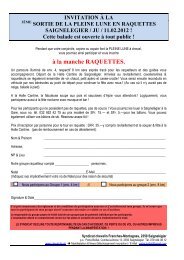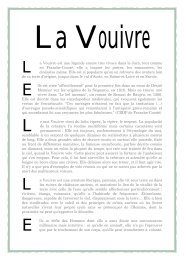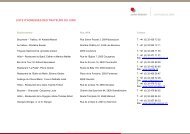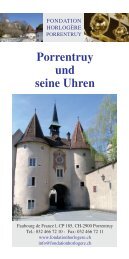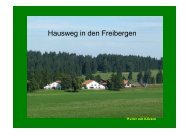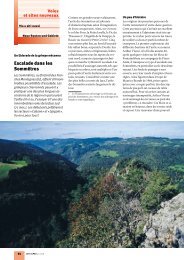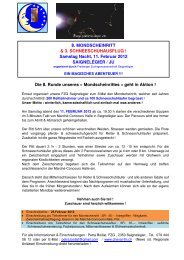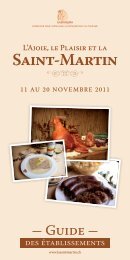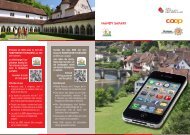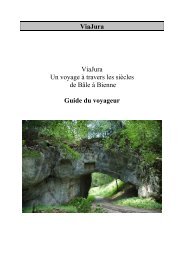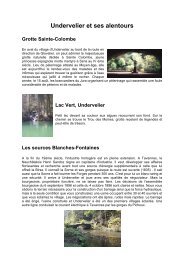DELÉMONT - Jura Tourisme
DELÉMONT - Jura Tourisme
DELÉMONT - Jura Tourisme
You also want an ePaper? Increase the reach of your titles
YUMPU automatically turns print PDFs into web optimized ePapers that Google loves.
2. Fontaine de la Samaritaine<br />
Située à l’angle de la rue de l’Eglise et de la Grand-rue, la fontaine de La Samaritaine a été réalisée par<br />
Laurent Perroud de Cressier, en 1564. Fontaine monumentale où le Christ et la Samaritaine se font face,<br />
accoudés à la margelle du puits; les piliers portent un entablement, sur lequel se trouve saint Jean-Baptiste<br />
enfant, tenant la croix et l’écu aux armes de la cité. Elle est la deuxième fontaine monumentale de la ville.<br />
Der Figurenbrunnen, der sich an der Ecke zwischen der Rue de l’Eglise und der Grand Rue befindet,<br />
wurde 1564 von Laurent Perroud aus Cressier errichtet. Monumentalbrunnen mit achteckigem Schaft,<br />
mit Christus und Samariterin am Sodbrunnen; reichreliefierte Viereckpfeilerchen, die eine Deckplatte<br />
tragen, darauf der Täuferknabe mit Kreuzstab und Stadtwappenschild. Es handelt sich um den zweiten<br />
Figurenbrunnen der Stadt.<br />
Located on the corner of Rue de l’Eglise and the Grand Rue, this fountain with figures was built by<br />
Laurent Perroud from Cressier in 1564. It is a stunning fountain with an eight-sided shaft, featuring the<br />
scene of Christ with the Samaritan woman at the well. The fountain also has elaborate relief work on the<br />
rectangular columns which support a stone slab, on which there is a statue of John the Baptist carrying<br />
the cross and a shield with the coat of arms of the city.<br />
3. Eglise Saint-Pierre et remparts<br />
PORRENTRUY<br />
Construite de 1321 à 1333, elle a été agrandie du côté nord, par la construction de chapelles latérales<br />
à la fin du 14 e siècle. Fenêtres de style gothique de 1583; portail néogothique de 1942. La restauration,<br />
de 1978 à 1982 a permis de retrouver l’architecture primitive. Vitrail du chœur : de l’artiste<br />
jurassien Jean-François Comment. Derrière l’église, les remparts supportent une belle esplanade<br />
d’où l’on devine la partie est de la ville. A droite, sur les remparts, petit pavillon d’angle à colombage.<br />
Sie wurde hauptsächlich 1321-33 erbaut und in der zweiten Hälfte des 14. Jahrhunderts durch<br />
Seitenkapellen gegen Norden erweitert. Aussen Flamboyant-Fenster von 1583; neogotisches Portal<br />
von 1942. Die 1978-82 durchgeführte Renovation gab der Kirche ihr ursprüngliches Aussehen<br />
zurück. Glasmalereien vom jurassischen Künstler Jean-François Comment. Hinter der Kirche befindet<br />
sich über den Stadtmauern eine schöne Terrasse, von der aus man einen Teil der Stadt überblicken<br />
kann. Rechts auf den Stadtmauern kleiner Fachwerkpavillon.<br />
This church was built from 1321-33 and then enlarged in the second half of the fourteenth century by<br />
side chapels on the north side. In 1583 the outside flamboyant windows were added; the neo-Gothic<br />
portal was built in 1942. The renovations of 1978-82, which were carried out by the architect Philippe<br />
Gressot, restored the original character to the church. The church has glass-paintings done by the<br />
<strong>Jura</strong> artist Jean-François Comment. Behind the church, there is a lovely terrace located on top of the<br />
city wall. From here, you have a wonderful view of the city. On the right side, on the city walls, there<br />
is a small half-timbered pavilion.<br />
27



